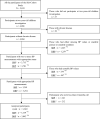Reference blood pressure values obtained using the auscultation method for 2-year-old Japanese children: from the Japan Environment and Children's Study
- PMID: 37389682
- PMCID: PMC10504195
- DOI: 10.1007/s10157-023-02370-w
Reference blood pressure values obtained using the auscultation method for 2-year-old Japanese children: from the Japan Environment and Children's Study
Abstract
Background: Reference blood pressure (BP) values for Japanese children based on a large number of measurements by auscultation have not yet been established.
Methods: This was a cross-sectional analysis of data from a birth-cohort study. The data from the sub-cohort study conducted for children at the age of 2 years in the Japan Environment and Children's Study from April 2015 to January 2017 were analyzed. BP was measured via auscultation using an aneroid sphygmomanometer. Each participant was measured in triplicate, and the average value of two consecutive measurements with a difference of less than 5 mmHg was recorded. The reference BP values were estimated using the lambda-mu-sigma (LMS) method and compared with those obtained via the polynomial regression model.
Results: Data from 3361 participants were analyzed. Although the difference between the estimated BP values by the LMS and the polynomial regression model was small, the LMS model was more valid based on the results of the fit curve of the observed values and regression models for each model. For 2-year-old children with heights in the 50th percentile, the 50th, 90th, 95th, and 99th percentile reference values of systolic BP (mmHg) for boys were 91, 102, 106, and 112, and that for girls were 90, 101, 103, and 109, respectively, and those of diastolic BP for boys were 52, 62, 65, and 71, and that for girls were 52, 62, 65, and 71, respectively.
Conclusion: The reference BP values for 2-year-old Japanese children were determined based on auscultation and were made available.
Keywords: Aneroid sphygmomanometer; Auscultation; Blood pressure; LMS method; Polynomial regression model; Reference value.
© 2023. The Author(s).
Conflict of interest statement
The authors have no conflicts to declare.
Figures

Similar articles
-
Oscillometric blood pressure by age and height for non overweight children and adolescents in Lubumbashi, Democratic Republic of Congo.BMC Cardiovasc Disord. 2018 Jan 19;18(1):9. doi: 10.1186/s12872-018-0741-4. BMC Cardiovasc Disord. 2018. PMID: 29351738 Free PMC article.
-
Blood Pressure Curve for Children Less than 10 Years of Age: Findings from the Ewha Birth and Growth Cohort Study.J Korean Med Sci. 2020 Mar 30;35(12):e91. doi: 10.3346/jkms.2020.35.e91. J Korean Med Sci. 2020. PMID: 32233160 Free PMC article.
-
Environments affect blood pressure in toddlers: The Japan Environment and Children's Study.Pediatr Res. 2024 Jan;95(1):367-376. doi: 10.1038/s41390-023-02796-8. Epub 2023 Aug 26. Pediatr Res. 2024. PMID: 37634037 Free PMC article.
-
Waist circumference percentiles in 2-18 year old Indian children.J Pediatr. 2014 Jun;164(6):1358-62.e2. doi: 10.1016/j.jpeds.2014.02.018. Epub 2014 Mar 18. J Pediatr. 2014. PMID: 24655536
-
Oscillometric and auscultatory blood pressure measurement methods in children: a systematic review and meta-analysis.J Hypertens. 2017 Feb;35(2):213-224. doi: 10.1097/HJH.0000000000001178. J Hypertens. 2017. PMID: 27870656 Review.
References
MeSH terms
LinkOut - more resources
Full Text Sources
Research Materials
Miscellaneous

